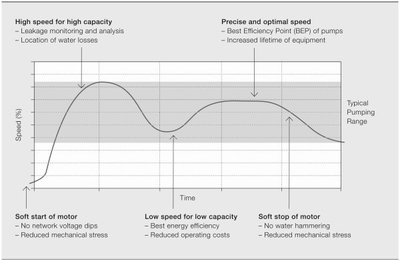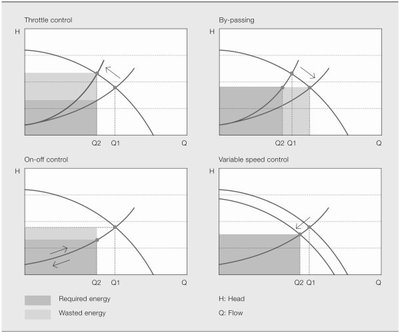Clever pumping
Climate change, increasing water demands due to global urbanisation and regulatory obligations are all making the water sector an attractive arena for technologies that can help reduce costs and contribute to reducing the effects of climate change. It is against this backdrop that the demand for intelligent process control equipment is surging throughout the water industry.
Variable speed drive (VSD) manufacturers are in the vanguard of the development of intelligent devices. The functionality being demanded from VSDs is manifold and includes enhanced connectivity, reduced energy consumption, minimised downtime and features that intelligently react to, as well as prevent, real problems, preferably before they cause damage.
The growing use of VSDs, particularly intelligent drives for pump control, represents a major departure from the standard operating practice of using control valves to vary fluid flow. With its low energy usage and low maintenance outlay, the total life cycle cost of a VSD-controlled pumping system can be significantly less than traditional pump technology. Other VSD benefits include smoother start-ups and production changes, more precise control during continuous operation and faster diagnosis of potential system problems before product quality or process operation is negatively affected.
The emergence of intelligent pumps is a critical step forward in the evolution of process management. With embedded intelligence, VSDs can provide pump control, pump condition monitoring, protection and traditional energy-saving benefits. Figure 1 shows a summary of the benefits of VSDs at the various operating points of a motor.

Pump cleaning
Consider, for instance, the antijam or antiragging function now found in several VSDs. A long-standing problem suffered by water companies is that of ‘ragging’, the fouling of pump impellers which consumes thousands of hours of maintenance time in sewage pumping stations and wastewater treatment plants around the world. Manually clearing the problem is a costly and unpleasant task requiring a maintenance team and frequently a crane. Downtime may extend to several days, during which time the backup systems are under additional pressure. A total system failure can result in effluent leakage, which has environment and human health implications as well as clean-up costs and legislation issues.
The antijam function prevents pumps and pipes from clogging by initiating a sequence of forward and reverse runs of the pump to clean the impeller.
Dedicated drives for pumps
But it is not just by unclogging impellers that the latest intelligent drive technology can enhance a pump’s life cycle. In fact, there are several pump-specific requirements that can be bundled into the functionality of the drive module that can make a drive specific for water and wastewater applications.
The idea of application-specific drives is something which IMS Research, a leading supplier of market research, has identified as a growing trend. With such drives, the user can reduce their total cost through shorter start-up times, lower integration costs and improved machine productivity. IMS Research estimates that low-voltage AC drive shipments to the global water and wastewater market will grow from US$448 million in 2010 to US$760 million in 2014.
Pumps are by far the biggest application area for variable speed drives. And all these pumps have specific requirements from flow calculation through to level control, all of which can be solved using the latest software now available. The drives’ pump-specific functions decrease the life cycle cost of the pumping systems, helping to save time and money, boost energy efficiency and reduce carbon dioxide emissions.
Typical of the applications which can now benefit from intelligent pump control are water pumping stations, many of which demand, in addition to the antijam feature mentioned above, level control and pump priority functions.
Level control
Level control is designed to control the filling or emptying of storage tanks containing wastewater or stormwater contaminated with dirt, gravel, litter and other debris. The function seeks to prevent sediment build-up on the tank walls by randomly varying the surface level within a preset range. Additionally, aggressive, fast-ramp starting creates a flush effect, thereby preventing blockages, while minimising energy consumption by running pumps within a favourable operating area.
Pump priority
Pump priority schedules pump operation to enable maintenance planning. It is intended for systems where the consumption rate varies with demand. For example, the drive can be programmed to operate higher capacity pumps during the daytime and smaller units at night. This allows for better maintenance planning and can boost energy efficiency by operating pumps closer to their best-efficiency point.
Energy saving
Energy saving lies at the heart of VSD use in pumping systems.
In general, the life cycle costs of a pump system depend on the power range and its in-service lifetime. However, typical costs for pump systems between 50 to 100 kW will be incurred through energy usage (between 70-80%) and maintenance (20-30%).
Over a 20-year period, the combined energy and maintenance costs may exceed 10 times the initial pump purchase price. These operating costs can be dramatically reduced through efficiency improvements.
Two common causes of pump system efficiency loss are pump oversizing and throttled valves. Poor pump performance can result in downtime, collateral damage to equipment and high maintenance costs.
In VSD-controlled pumping systems it is also possible to run the pump at higher than nominal rotational speeds. Normally, the motor is designed so that it enables operation in the area of higher power range. This makes it possible to run the same VSD-controlled pump in a higher power range area compared to an on-off controlled pump. This mode of operation enables a pump with a smaller power rating to be used, which also reduces initial investment cost. This is valid for situations in which peak flows occur every now and then (see Figure 2).

The energy-saving benefits of VSDs are well documented, with savings typically from 20 to 60% readily achievable in speed-controlled pump applications. Now, as part of the added intelligence within a drive, manufacturers are including features such as energy optimisation, which improves the total energy efficiency of the pumping system.
Tracking this entire energy saving is possible through in-built energy counters that show how much energy has been used and saved in kWh, currency or volume of CO2 emissions.
Pressure and flow control
Using VSDs to control pressure and flow improves flow management, minimises maintenance and reduces electrical energy requirements.
A pressure boosting station, for example, feeds water directly into the distribution system and seeks to maintain a constant pressure in the pipes. With smooth VSD control there are no pressure shocks causing noise, erosion or leakage in the pipeline.
Intelligent VSDs also increase uptime: parallel drives enable the system to run with 100% redundancy. If a defect occurs in one of the pumps, motors or drives, the others will continue operation without any interruption. Pump stations are sometimes located remotely and service activities might take some time. With redundancy, the pump station operation is trouble free with minimised downtime.
Further, the running time of the pumps can be controlled with the pump priority function (see earlier) to ensure that wear and tear on all pumps is the same.
Where several parallel pumps are operated together and the required flow rate is variable, a function called multipump control maintains stable process conditions optimising the speed and number of the pumps needed. This function provides the most energy-efficient way to operate parallel pumps.
Sleep and boost
Another pressure-related function is that of sleep and boost.
Traditionally, standard PID control may allow a pump to operate at undesirably low speeds for prolonged periods of time. This can cause mechanical issues with certain pump types and in general wastes energy, since most pumps do not generate significant flow at low speeds.
A sleep and boost function, however, lets the drive go to ‘sleep’, meaning that the drive output will shut off and the pump will stop. This is suitable for clean water pumping systems during night-time when water consumption falls. If the system pressure drops below a defined level, this function detects slow rotation and runs the pump to boost the pressure in the pipeline or water level in the tank prior to shutdown. This extends the pump’s sleep time and therefore saves energy. The pressure is continuously monitored and pumping restarts when the pressure falls below the minimum level. It also avoids unnecessary starting and stopping and helps to flush the pipelines.
Flow calculation
Another feature now built into drives is flow calculation. This function provides the drive with a flow meter routine that enables the pumped volume to be monitored by the VSD, without any additional components. This is a useful feature in systems where data about the total flow during a specific time period is needed.
Remote monitoring
Some drives can connect to major automation systems via an ethernet connection or GSM wireless network. This is achieved with a dedicated gateway concept between the fieldbus systems and the drives. A remote monitoring module gives simple access to the drive via the internet, communicating via a standard web browser. The user can set up a virtual monitoring room wherever there is a PC with an internet connection or via a simple dial-up modem connection. This enables remote monitoring, configuration, diagnostics and, when needed, control.
Remote monitoring provides easy access to pumping systems, even in faraway locations, thereby avoiding unnecessary site visits and saving time. Through the use of ethernet adapters, process data, logs and event messages concerning pumped volumes, tank levels and other operating conditions can be sent independently.
Summary
Drive modules specially designed for water and wastewater applications can significantly enhance a pump’s life cycle. With up to 60% energy savings possible along with reduced carbon dioxide emissions and payback on investment often within two years, the future for the intelligent variable speed drive is certainly looking bright.
By Sanna-Kaisa Ehanto, ABB Drives, Helsinki, Finland
Encore Tissue improves plant reliability with new DCS
An Australian toilet paper and paper towel manufacturer needed a modern DCS solution that would...
Data-driven insights: how AI is transforming industrial processes
Although most of the underlying mathematics of control systems stems from the 1960s, it has only...
From smart to vulnerable: The hidden costs of the digitalisation of utilities
For Australia’s critical infrastructure sectors proactive investment in cybersecurity is no...







